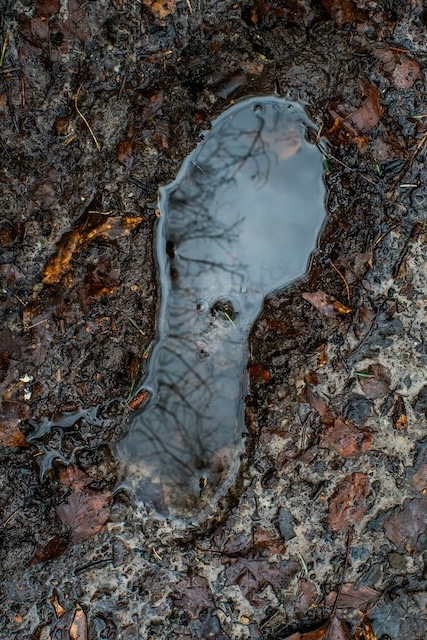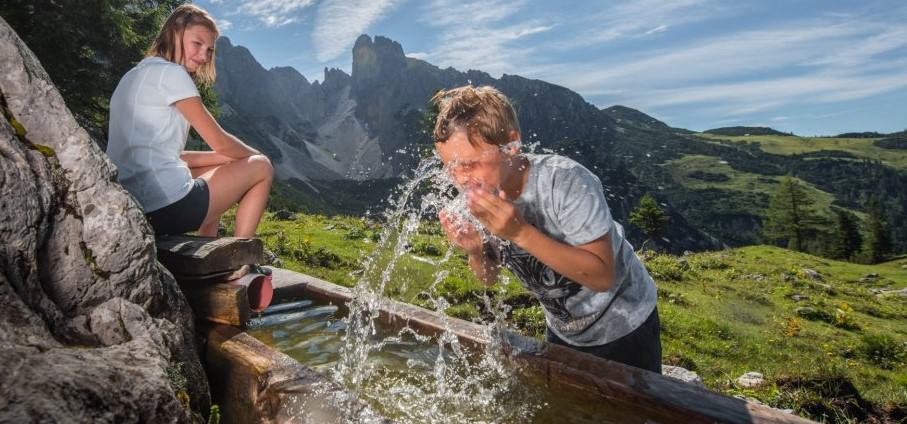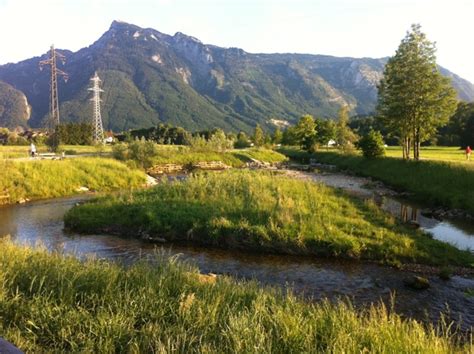
Nature-based therapies in the non-alpine terrain of Austria
Written by Anna Rokita, Florian Priller, Matthias Kraus, Alexander Lasser und Melanie Quehenberger
Introduction
Nature-based therapy is gaining global attention for their Integrated and Ecological approach. Blending traditional treatments with the healing power of natural environments in Austria, innovative projects including natural settings into psychotherapy, physical rehabilitation, and wellness practices are getting more attention! Austria offers a rich variety of nature-based therapies. From forest and water therapies to barefoot walking, peat treatments, and “Kneipp” methods! These innovative approaches support physical, mental, and emotional well-being. This overview highlights selected Austrian projects and practices that showcase the country’s commitment to holistic health and sustainable wellness tourism.
Nature as co-therapist
Austria’s first certified healing forest, created with Göttweig Abbey, is a pioneering nature-based therapy project. Covering 53 hectares, the Göttweig Healing Forest offers guided walks inspired by Japanese forest bathing, helping participants reduce stress, reconnect with nature, and enhance well-being.
Scientific evidence supports forest therapy’s capacity to reduce blood pressure, enhance immune function, and improve people’s mood. Project leader Susanne Bauer, together with Udo Brändle and Uwe Rinner, recently showcased the Göttweig Healing Forest and its innovative concepts at the International Society of Forest Therapy (ISFT) Congress in Lithuania (1). Krems, with its natural landscapes and accessible woodland provides an ideal environment for holistic health promotion and stress reduction (1,2).

Photo by Lucas van Oort on Unsplash
Barefoot running
The article “Raus aus dem Schuh” by Physio Austria emphasizes the importance of barefoot walking for foot health. Not only barefoot walking, but also barefoot running is beneficial. Modern shoes are often too tight and can weaken the foot muscles, leading to misalignments such as hallux valgus. Barefoot walking, particularly barefoot running, strengthens the foot muscles, improves body awareness, and can prevent posture-related issues. However, barefoot running requires an adjustment in running style and should be professionally trained (10).
Matthias Zuckerhut, a physiotherapist and coach in Vienna, specializes in natural barefoot running technique. In his coaching, he teaches how to reawaken the original functions of the feet and body. The technique is based on biomechanical and evolutionary principles as well as research and experience from Prof. Daniel E. Liebermann (Harvard University, USA) and Lee Saxby (UK). This approach reactivates the natural cushioning and stability of the foot, leading to better overall coordination and proprioception (11,12).
Water therapy in Abtenau
Abtenau Water Therapy utilizes the mineral-rich springs of the Abtenau region, notably the Anna and St. Rupertus springs, whose waters are naturally high in sodium, calcium, chloride, and sulphate giving it a distinctive, slightly bitter taste. Traditionally, this water has been used for drinking and bathing. Recent studies have highlighted the health benefits of combining bathing in Abtenau’s healing water with physical activity such as mountain hiking (2).
Research from the Paracelsus Medical Private University has demonstrated that regular baths in mineral water, when paired with exercise, can enhance immune function, balance, and overall well-being—especially in older adults. Participants reported improved skin condition and increased vitality after a week-long program of hiking and daily mineral baths (3).
Today, visitors to Abtenau can experience the therapeutic effects of this natural resource through guided “fountain of youth” hikes and wellness programs, making it a unique destination for health tourism in the Austrian Alps.

Results from Abtenau Interreg Project “Jungbrunnen-BERG-Study“
Bathing in Abtenau’s highly mineralized healing water increases T-helper cell counts (p=0.011) and improves the T-helper to cytotoxic T-cell ratio by day 60 (p=0.015), suggesting a rejuvenation effect. Gender differences were observed: women showed a significant increase in naïve T-helper (p=0.033) and naïve cytotoxic T-cells (p=0.039). No effects were found on memory T-cells or their ratios to naïve cells (2).
Projekt:Leben – Nature-Oriented Behavioral Therapy in Mondsee
Projekt:Leben, located in Mondsee (upper Austria), offers a nature-oriented behavioural therapy, which “combines elements of behaviour therapy with experiences and activities in nature.” (4) This approach utilizes nature as a therapeutic medium to enhance mindfulness, emotional processing and self-reflection, and stress reduction to treat mental and physical health issues, for example depression, trauma, and behavioural disorders like ADHD. Activities such as forest bathing, gardening, and outdoor exercise promote relaxation, improved mood, enhanced focus, and encourage personal growth and responsibility.
Even small integrations of nature into daily life can significantly increase well-being. Such integrations could be fresh air breaks at work, daily nature rituals, be it a walkin the forest or watching the sunset, or even a nature-related environment like apicture above the dining table (4).
Leoppoldskroner Moor – Therapeutic peat applications, Paracelsus Bad, Salzburg
For hundreds of years humans have been aware of the healing effects of natural resources, such as peat. The Paracelsus Bad in Salzburg offers evidence-based balneotherapy utilizing high-quality peat from the local “Leopoldskroner Moor”, one of Europe’s most renowned peat bogs (Best-known peat bogs). The “black gold” (5) has been used for medical purposes in Salzburg since 1820 and is crushed and prepared for treatment in the own “peat kitchen”. Medical peat is rich in humic acids, minerals (magnesium, iron, copper), and plant-derived organic compounds and is applied in the form of packs, wraps, and baths. These applications are indicated for chronic musculoskeletal disorders, rheumatism, dermatological conditions, and muscular tension. The combination of thermal and biochemical effects promotes analgesia, detoxification, and enhanced circulation (5).
The local company “SonnenMoor” further extends these benefits through a range of peat-based products, including peat baths, skincare products, ointments, as well as drinking cures and capsules for oral intake. Representing a sustainable, nature- conscious approach, the peat is harvested by hand from the natural unfertilized moor meadow in Leopoldskron and produced and shipped in Anthering, Salzburg (6).

Hydrotherapy and Balneotherapy in Austrian Spa Towns
Austria’s spa towns like Bad Gastein, Bad Ischl or Bad Aussee are known for their exquisite thermal water. Bad Gastein is unique worldwide with its radon therapy. Bad Ischl has one of the largest salt deposits in Austria and is known for its brine therapy. Classical hydrotherapy and balneotherapy use this thermal water to support
musculoskeletal rehabilitation, alleviate chronic pain, and manage dermatological and rheumatic conditions. Bad Gastein’s radon therapy and Bad Ischl’s brine treatments are particularly notable for their unique mineral profiles and historical significance. Austria’s spa destinations highlighting its rich heritage in natural healing modalities (7–9).
Brine Therapy – Bad Ischl
Even the Austrian imperial family trusted the healing power of brine therapy, frequently visiting Bad Ischl in the Salzkammergut, which became a renowned wellness destination. Brine-based treatments remain valued today for their preventive, restorative, and therapeutic effects. Salt, brine, sulphur, and brine mud support respiratory health, musculoskeletal function, and the treatment of burnout and chronic inflammatory conditions.
Naturally rich in minerals, the Bad Ischl brine contains 25–30 grams of salt per liter and is used in pure or customized forms across various treatments. Salt concentrations range from 0.9% to 12%, with the general spa pool matching the 3% level of the Adriatic Sea.
Brine baths are central to therapy in the region, offering deep relaxation through buoyancy and promoting holistic well-being. They relieve pain, reduce inflammation, boost circulation and metabolism, support organ function and immune health, and help regenerate body and mind. Used in baths, massages, and hydrotherapy, brine is absorbed through the skin, triggering beneficial biological processes. It’s also gentle enough for use in cancer care. When inhaled, brine mist soothes respiratory conditions by reducing inflammation, loosening mucus, and aiding mucous membrane regeneration (8)
The Austrian Kneipp Association
The Austrian Kneipp Association has around 30,000 members and 200 Kneipp Active Clubs (KACs) offering diverse health and wellness programs nationwide. It publishes “Kneipp BEWEGT”, a magazine with practical health tips. The association is volunteer-run, non-profit, and aims to improve well-being through the Kneipp method.
Pastor Sebastian Kneipp developed a gentle water treatment using a low-pressure stream that starts away from the heart to ease the body into cold stimuli. The therapy stimulates skin temperature receptors without overstimulating mechanoreceptors. Knee casts are especially helpful for circulation issues. Treatments alternate warm and cold phases to activate the body’s natural temperature regulation.
Kneipp therapy has deep roots in Austria. The first clubs appeared in 1892, with a national association formed in 1897. Though dissolved during the Second World war, it was reestablished in 1949. Kneipp therapy is a medically recognized natural healing method with European roots and a holistic philosophy. Austrian doctors can become certified Kneipp physicians, with training accredited by the Austrian Medical Association. It also complements other natural therapies like homeopathy and traditional Chinese medicine (10).
Nature-based physiotherapy with Claudia Pöchaker
Insights into a resource-oriented therapy concept between meadow paths, forest air and functional training.
While physiotherapy traditionally take place in practice rooms or rehabilitation facilities, a growing field of alternative settings is implementing – nature-based therapy. Claudia Pöchacker, a freelance physiotherapist and certified hiking guide from Lower Austria, combines physiotherapy expertise with structured exercise sessions in the countryside – whether as part of guided hikes or individually designed outdoor home visits. Her concept is an example of how nature and therapy can be combined in a simple way – with tangible added value for both the patients and therapists alike.
Nature as a co-therapist
Therapy in nature works on several levels. In addition to the purely physiological effects such as stimulating circulation, coordination training or muscle strengthening, Pöchacker describes the psychological effect as a key factor:
“It doesn’t feel like therapy, where you must perform or work through exercises. It creates a more relaxed, natural situation.” ~ Claudia Pöchacker
Many participants report that they move more freely, feel less observed and feel less pressure to perform. Nature supports this effect – with open spaces, changing stimuli, fresh air, light and natural sounds. Walking itself – steady, rhythmic, community based – has a calming effect on the autonomic nervous system. Spontaneity and lightness are also often created in passing.
At the same time, therapists also benefit:
“It also benefits me! It’s a balance to everyday practice – less structured, but more real.” ~ Claudia Pöchacker
Nature not only changes the setting, but also the relationship between the patients and therapists – it becomes more direct, more present and often less hierarchical.
Therapeutic hiking: Group offers with an exercise unit
Pöchacker’s group hikes take place in the Lower Austria region, covering around 7 km with an elevation gain of around 500 metres and include a targeted movement unit on physiotherapeutically relevant topics such as spinal mobilization, balance training or stabilization training. Claudia Pöchacker also explains her concept of therapeutic hiking in a short video, which is available at the end of this article. The exercises are carried out without additional equipment and are adapted to the weather, surface and group level – In other words, building strength in cooler conditions and promoting relaxation and balance during the summer heat.
The goal is not to prove athletic performance, but to enjoy exercise in nature, combined with physiotherapeutic know-how. The personalised setting of the small group (max. 8 patients) allows individual attention to be paid to the participants. The subsequent retreat also strengthens the social experience – an aspect that often receives limited attention in a therapeutic context.
In addition to these low-threshold hikes, Claudia Pöchacker also offers more challenging tours in cooperation with the Alpine Club (“Alpenverein – Edelweiss”).
These are aimed at more experienced participants who would like to walk longer or technically more demanding routes but still value a physiotherapeutically supervised experience.
This creates a diverse format that is suitable for different target groups and training levels – from beginners to more ambitious hikers. A decisive advantage: no prescription is required for participants. The tours are preventive and show how accessible and effective nature-based therapy can be.
Rethinking home visits: therapy on the doorstep
In addition to the walks, Pöchacker also purposely organizes house calls outside of home. Staircases, parks, sidewalks and supermarkets become realistic exercise locations. Especially in neurological aftercare, many patients experience uncertainty after a rehabilitation stay! They know what would be possible in terms of motor skills – but the mental barrier to doing it alone in everyday life is often challenging.
“Sometimes we are simply a mental support. The real blockage is in the head – nature helps to overcome it.” ~ Claudia Pöchacker
By walking together, insecurities are overcome step by step: Crossing traffic lights, spiral staircases, public transport, encounters in the street. The setting allows for functional, everyday training that traditional practice rooms can´t offer.
What does this mean for other physiotherapists?
Nature-based therapy can be implemented in different professional contexts – whether as a freelancer or as an employee. The examples show that it doesn’t take much:
– A stable route in the environment
– A manageable selection of exercises
– Clothing suitable for the weather
– And above all: to consciously leave the setting
In rehabilitation facilities, the first steps could take the form of walks on the ground or outdoor mobilization units. Individual therapy sessions can also be arranged in the park or yard. What is important here is not perfection, but the attitude: therapy can and may also take place outside!
“Often, all that’s missing is the idea that it’s even possible.” ~ Claudia Pöchacker
More than just a change of location
Nature-based therapy is more than just training in the countryside – it is a change of perspective. It opens new scope for function, motivation and relationship building. It demands little but has a great effect. It can be a low-threshold, effective and sustainable component of physiotherapy, particularly in neurological aftercare, for chronic complaints or for prevention.
For therapists, it offers the opportunity to enrich their own working day, recharge their batteries – and enable patients to take a real step back into everyday life by taking a few steps…out.
In conclusion, Austria’s diverse nature-based therapies demonstrate the powerful synergy between traditional healing and the natural environment. By integrating forest bathing, mineral water treatments, peat applications, barefoot running, and Kneipp therapy, these approaches offer effective, evidence-based solutions for physical and mental health. Austria’s commitment to innovation and sustainability in wellness not only preserves its rich therapeutic heritage but also provides valuable models for holistic health promotion worldwide.
References
Header image by Alexandra Smielova on Unsplash
- paul@isft.info. Waldtherapie und Heilwälder [Internet]. Internationale Gesellschaft für Waldtherapie. 2023 [cited 2025 May 25]. https://isft.info/de/waldtherapie-und-heilwalder/
- Abtenauer Heilwasser – TVB Abtenau [Internet]. 2020 [cited 2025 May 21]. https://abtenau-info.at/rund-ums-jahr/abtenauer-heilwasser/
- Paracelsus Medizinische Privatuniversität (PMU) [Internet]. [cited 2025 May 25]. Institut für Ökomedizin der Paracelsus Universität. https://www.pmu.ac.at/forschung-innovation/institute-zentren-und-programme/institut-fuer-oekomedizin
- PROJEKT-LEBEN®: Psychotherapie, Beratung & psychosoziale Gesundheit | Mondsee, Salzkammergut, nahe Salzburg. [Internet]. [cited 2025 May 16]. Naturorientierte Verhaltenstherapie. https://www.projekt-leben.at/unser-leistungsangebot/naturorientierte-verhaltenstherapie/
- Leopoldskroner Moor : Kur & Gesundheit : Paracelsus Bad in Salzburg [Internet]. [cited 2025 May 20]. https://www.paracelsusbad.at/de/kur-gesundheit/leopoldskroner-moor
- SonnenMoor [Internet]. [cited 2025 May 20]. SonnenMoor: Naturprodukte aus dem Leopoldskroner Moor. https://www.sonnenmoor.at/blogs/news/sonnenmoor-naturprodukte-aus-dem-leopoldskroner-moor
- Kur und Heilquelle in Gastein bei Salzburg [Internet]. [cited 2025 May 21]. https://www.gastein.com/vitalitaet/kur/
- EurothermenResorts [Internet]. [cited 2025 May 21]. Sole-Therapie. https://www.eurothermen.at/bad-ischl/sole-therapie/
- DocCheck M bei. DocCheck Flexikon. [cited 2025 May 21]. Balneotherapie. https://flexikon.doccheck.com/de/Balneotherapie
- Über uns – Österreichischer Kneippbund & Aktiv-Clubs [Internet]. 2020 [cited 2025 May 21]. https://kneippbund.at/ueber-uns/
- Über mich – Claudia Pöchacker [Internet ]. [cited 2025 Jun 1]. https://www.poechacker.at/
